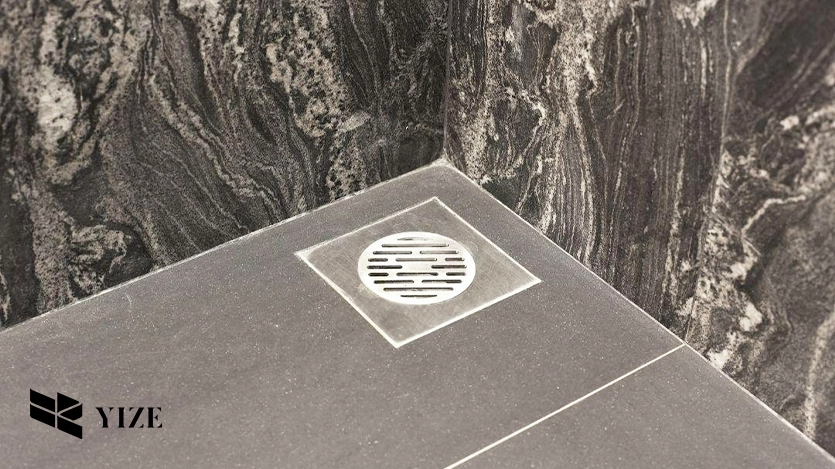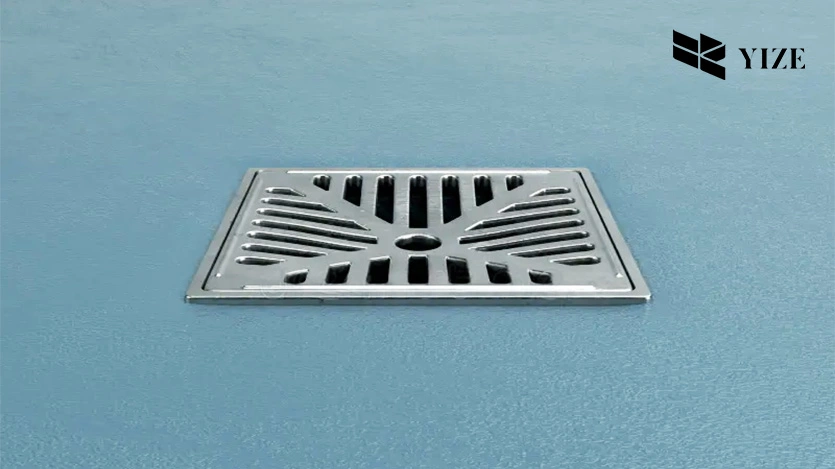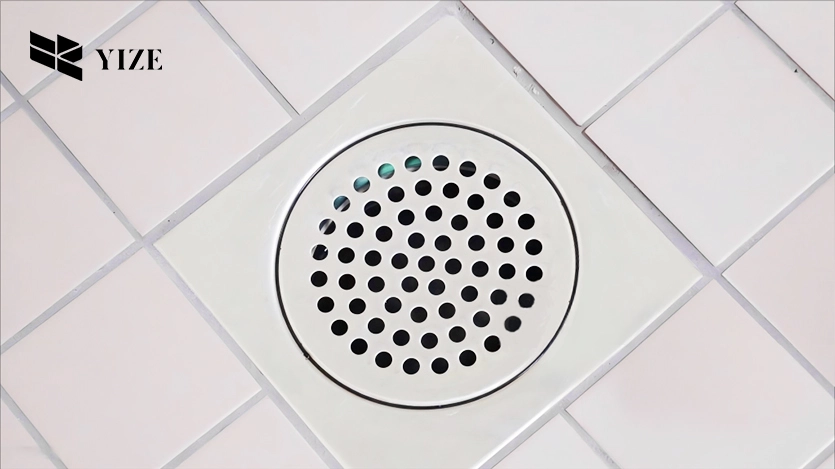
You’ve spent weeks choosing the perfect tiles, but what about the drain? That small metal square can make or break your bathroom’s entire look. 73% of bathroom renovations overlook drainage aesthetics until it’s too late.
Here’s what we’ll cover to get your drains right:
- How to match drain styles with different tile patterns
- Key performance features that prevent water pooling and odors
- Installation considerations for various bathroom layouts
- Material options and their long-term durability
- Cost vs. value analysis for different drain types
We’ve been helping homeowners nail this balanceat YZDRAIN for over a decade. Our customers often tell us they wish they’d thought about drains before picking tiles. That’s why we’re sharing what we’ve learned—so you don’t make the same mistake.
I. How to Match Drain Styles With Different Tile Patterns
Your drain choice can either complement your tiles or completely clash with them. We’ve seen stunning marble floors ruined by basic round drains that stick out like a sore thumb.
1. Large Format Tiles Need Linear Drains
Big tiles demand clean lines. A linear shower drain creates a seamless look that doesn’t break up the visual flow. Position it along one wall, and you’ll get a single slope that’s easier to install, too.
Pro tip: Match your drain length to tile dimensions. Got 24-inch tiles? Consider a drain that’s 24 or 48 inches long. The alignment looks intentional, not accidental.
2. Small Mosaic Tiles Play Nice With Square Drains
Mosaics offer flexibility. Square drains blend naturally with grid patterns, especially when you center them within the tile layout. Our square shower drains come with adjustable trim pieces that help you nail the perfect fit.
The trick? Count your tiles. Place the drain where full tiles meet—never in the middle of a cut tile.
3. Hexagonal and Geometric Patterns
These trendy patterns need special attention. A triangular shower drain works brilliantly in corners where hexagonal tiles converge. It turns a potential awkward spot into a design feature.
For herringbone or chevron patterns, go linear. Align the drain perpendicular to the pattern direction. This creates visual contrast that actually enhances the tile work.
4. Material Matching Matters
Stainless steel remains versatile, but consider these matches:
- Brushed finish → Matte tiles
- Polished finish → Glossy tiles
- Black PVD coating → Dark grout lines
Remember, your drain grate pattern should echo your tile rhythm. Slotted grates suit linear designs, while perforated patterns complement busy tile work.
II. Key Performance Features That Prevent Water Pooling and Odors

Nobody wants ankle-deep shower water or that mysterious sewage smell wafting through their bathroom. The right drain features solve both problems before they start.
1. Flow Rate Is Your First Defense
You need at least 1.5 gallons per minute drainage capacity. Sounds technical? Think of it this way—your rainfall showerhead dumps water faster than a standard drain can handle.
Our horizontal-outlet drains hit 2.1 GPM thanks to their wider channels. That extra capacity means water disappears as fast as it falls.
2. The Odor-Blocking Triple Threat
Three features work together to keep smells where they belong:
- Deep water seal (minimum 2 inches)
- Removable trap for easy cleaning
- Anti-backflow valve
YZDRAIN’s dry and wet deodorization system takes this further. The dual-seal design blocks sewer gases even when the trap dries out during vacations. No more coming home to that smell.
3. Slope Integration Beats Standing Water
Traditional center drains need four-way slopes. Miss one angle? Hello, puddles. Linear drains require just one slope—way harder to mess up.
The magic number? 2% grade (1/4 inch per foot).Our 360° rotatable outlet adapts to existing slopes, saving you from jackhammering perfectly good concrete.
III. Installation Considerations for Various Bathroom Layouts
Your bathroom’s quirks determine which drain works best. We’ve installed thousands, and layout matters more than most people realize.
1. Curbless Showers Need Special Planning
Going barrier-free? You’ll need:
- Recessed drain channel (adds 1-2 inches depth)
- Pre-sloped shower base system
- Offset outlet for tight joist spaces
Our side outlet shower drains excel here. The horizontal connection means less digging into your subfloor—critical when every inch counts.
2. Small Bathrooms Love Wall Drains
Tight on space? Mount your linear drain against the wall where it does double duty:
- Catches door splashes
- Simplifies single-slope installation
- Maximizes usable shower floor
3. Corner Showers Work With Triangular Drains
That awkward corner becomes an asset. Triangular drains fit naturally where walls meet, eliminating weird tile cuts. Plus, the corner position creates optimal water flow from all directions.
Pro tip: Check your joist direction first. Running perpendicular? You’ll need our rotatable outlet to avoid costly plumbing reroutes.
4. Multi-Head Shower Systems
Got body sprays or dual showerheads? Standard drains can’t keep up. You need either:
- Longer linear drains (36+ inches)
- Multiple drain points
- High-capacity channels
The sweet spot? Position your main drain opposite the primary water source. Secondary sprays should angle toward—not away from—the drain.
IV. Cost vs. Value Analysis for Different Drain Types

The cheapest drain isn’t always the best deal when you factor in installation, maintenance, and how long it’ll actually last.
1. Breaking Down Real Costs
Here’s what you’re really paying for with each drain type:
| Drain Type | Unit Cost | Installation Cost | Lifespan | 10-Year Total Cost | Best For |
| Basic Round PVC | $25-45 | $150-250 | 5-7 years | $450-850 | Rental properties, budget renovations |
| Standard Square SS | $75-150 | $200-350 | 10-15 years | $275-500 | Mid-range bathrooms, reliable performance |
| Linear Channel | $200-400 | $300-500 | 15-20 years | $500-900 | Modern designs, curbless showers |
| Triangular Corner | $100-200 | $250-400 | 10-15 years | $350-600 | Small showers, corner installations |
| 360° Rotatable | $250-450 | $200-300 | 15-20 years | $450-750 | Retrofit projects, challenging layouts |
Installation costs assume professional work. DIY cuts these by 60-70%.
2. Hidden Value Factors
The sticker price tells half the story. Consider these money-savers:
- Reduced Tile Cuts → Linear drains need fewer custom cuts. That’s 2-3 hours less labor ($150-225 saved).
- Water Damage Prevention → Quality drains with proper seals prevent subfloor rot. One leak repair costs $800-2,500.
- Resale Appeal → Modern drains add perceived value. Realtors report linear drains can bump bathroom appeal by 10-15%.
3. When to Splurge vs. Save
Spend more when:
- You’re doing a forever-home renovation
- The bathroom gets heavy daily use
- You want specific aesthetics
Save money when:
- It’s a temporary fix
- The bathroom rarely gets used
- You’re selling soon
YZDRAIN’s sweet spot?Our horizontal-outlet models. They cost more upfront but eliminate expensive waterproofing mistakes. The peace of mind alone makes them worth it—especially with our 10-year warranty backing you up.
V. Your Dream Bathroom Starts With YZDRAIN
Choosing the right floor drain transforms your shower from functional to fantastic.
Remember these essentials:
- Match drain styles to tile patterns—linear for large format, square for mosaics
- Prioritize 2+ GPM flow rates and proper odor-blocking features
- Consider your bathroom layout before buying
- Factor installation and long-term costs into your budget
We’ve helped thousands of homeowners find their perfect drain match at YZDRAIN. Our range covers every style need, while our 360° rotatable outlets and horizontal designs solve those tricky installation challenges. Plus, with proven performance in over 47 countries, you’re getting drains that actually last.
FAQs
Q1: Can I install a linear drain with existing tile?
Yes, but it’s tricky. You’ll need to cut tiles and adjust slopes. Our 360° rotatable outlet drains make retrofits easier since they adapt to your current plumbing angles.
Q2: How often should I clean my shower drain?
Monthly for hair removal, quarterly for deep cleaning. Drains with removable covers and accessible traps make this a 5-minute job instead of a weekend project.
Q3: What’s the difference between side and center outlets?
Side outlets connect horizontally—perfect for curbless showers or second-floor bathrooms. Center outlets go straight down, ideal when you have open space below.
Q4: Do I need a plumber to install a new drain?
Basic swaps? Handy DIYers can manage. New installations or layout changes need pros. The wrong slope means standing water forever—not worth risking.
